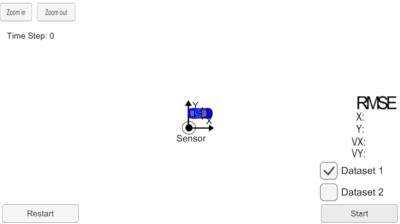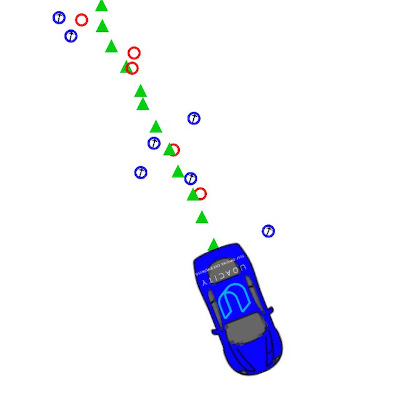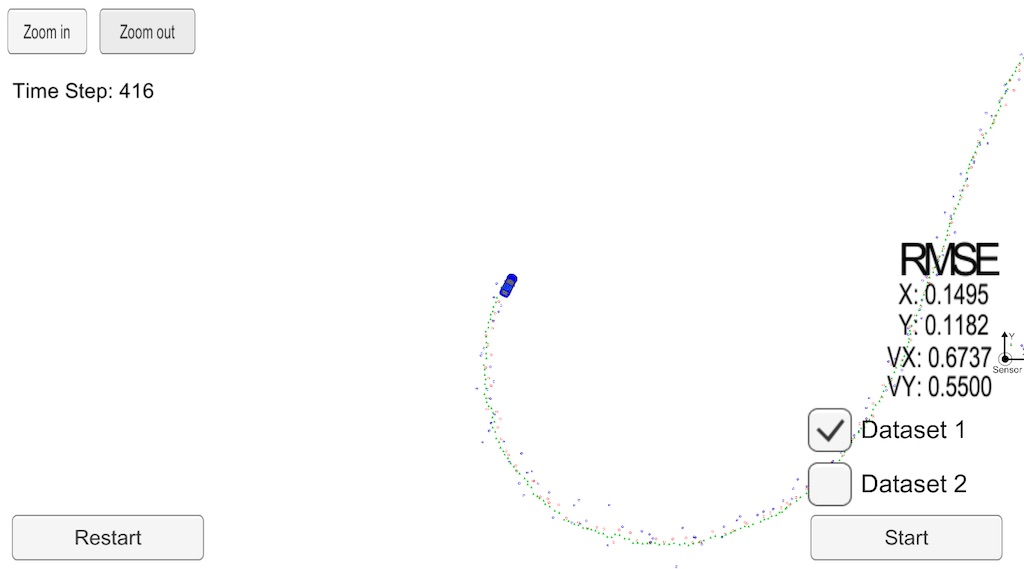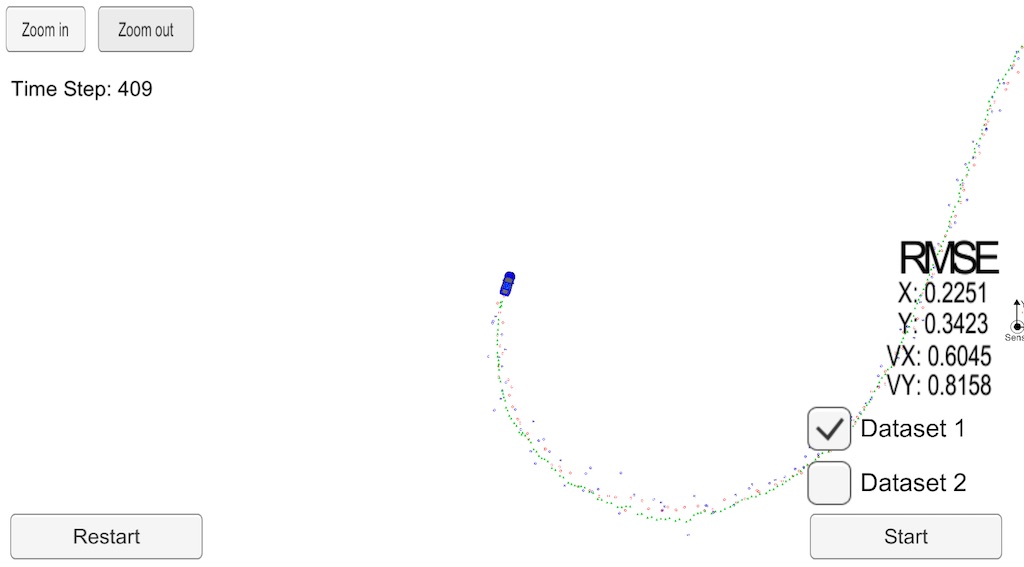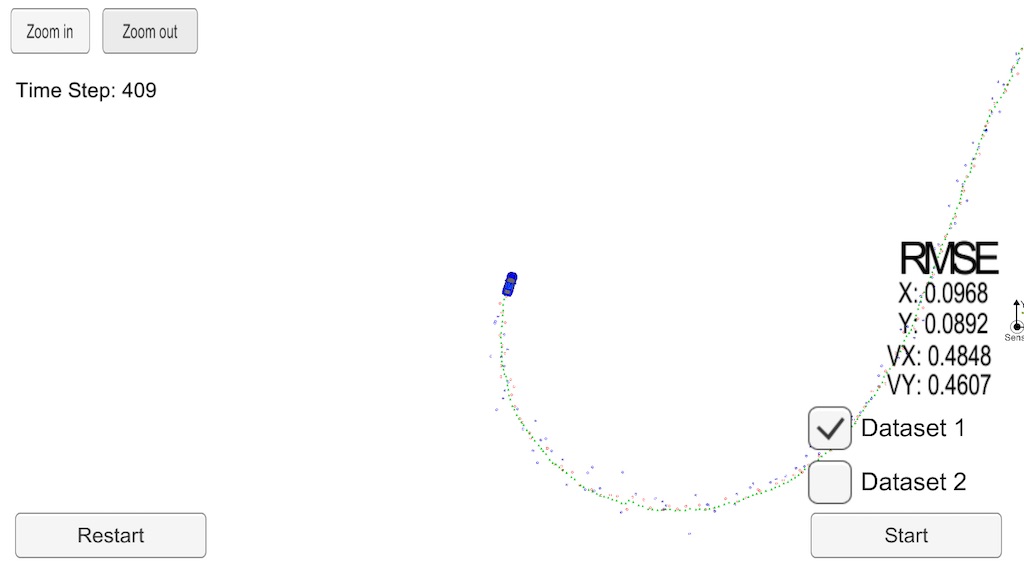Self-Driving Car Engineer Nanodegree Program
In this project a Kalman Filter/Extended Kalman Filter is utilized to estimate the state of a moving object of interest with noisy lidar and radar measurements.
The sensor fusion algorithm follows the general processing flow. The first measurements is used to initialize the state vectors and covariance matrices. Following the initialization, with the next measurement received, the algorithm predicts the object position at the current timestep and then updates the prediction using the new measurement. The implementation is set up to handle both lidar and radar measurements. The lidar measurements are handled with a standar Kalman Filter, while the radar, due to non-linearity, is handled with an Extended Kalman Filter.
In the results section, the final implementation results are presented. The accuracy for lidar only, radar only, and both sensors combined is presented. It shows that utilizing both lidar and radar together provides the best accuracy.
The implementation is considered succesful when achieving lower RMSE values than the prescribed [.11, .11, 0.52, 0.52] for px, py, vx, and vy repectively. The current implementation succeeds in this by achieving an RMSE of [0.10, 0.09, 0.48, 0.46].
The following files have been edited to complete the project
FusionEKF.cpp- Initialize the Kalman Filter
- Initialize variables and matrices (x, F, H_laser, H_jacobian, P, etc.)
- Initialize the Kalman filter position vector with the first sensor measurements
- Modify the state transition F matrix and Q matrix prior to the prediction step based on the elapsed time between measurements. Time is measured in seconds
- Call the update step for either the lidar or radar sensor measurement. Because the update step for lidar and radar are slightly different, there are different functions for updating lidar and radar
kalman_filter.cpp- Implement predict and update equations for the Kalman Filter and Extended Kalman Filter
Tools.cpp- Calculate the Root Mean Square Error (RMSE)
- Calculate the Jacobian matrix
This project involves the Term 2 Simulator which can be downloaded here. The simulator provides measurement data from a lidar and radar tracking a moving car.
The main protocol that main.cpp uses for uWebSocketIO in communicating with the simulator is as follows:
INPUT: values provided by the simulator to the c++ program
["sensor_measurement"]=> the measurement that the simulator observed (either lidar or radar)
OUTPUT: values provided by the c++ program to the simulator
["estimate_x"]<= kalman filter estimated position x["estimate_y"]<= kalman filter estimated position y["rmse_x"]["rmse_y"]["rmse_vx"]["rmse_vy"]
Image legend:
Red circles: lidar measurements areBlue circles: radar measurements with an arrow pointing in the direction of the observed angleGreen triangles: estimation markers from running the Kalman Filter
The figure below shows what the simulator looks like when the C++ program is using its Kalman Filter to track the object. The simulator provides the measured data (either lidar or radar), and the C++ feeds back the measured estimation marker (green), and RMSE values from its Kalman Filter.
- openssl libuv cmake zlib (installed via brew or apt)
- uWebSockets
This repository includes two files that can be used to set up and install uWebSocketIO for either Linux or Mac systems.
install-mac.shinstall-linux.sh
For windows you can use either Docker, VMware, or even Windows 10 Bash on Ubuntu to install uWebSocketIO.
- cmake >= 3.5
- All OSes: click here for installation instructions
- make >= 4.1 (Linux, Mac), 3.81 (Windows)
- Linux: make is installed by default on most Linux distros
- Mac: install Xcode command line tools to get make
- Windows: Click here for installation instructions
- gcc/g++ >= 5.4
- Linux: gcc / g++ is installed by default on most Linux distros
- Mac: same deal as make - install Xcode command line tools
- Windows: recommend using MinGW
Once the install for uWebSocketIO is complete, the main program can be built and run by executing the following commands from the project top directory.
$ mkdir build
$ cd build
$ cmake ..
$ make
$ ./ExtendedKFNote! On windows, you may need to run: cmake .. -G "Unix Makefiles" && make
Follow the guide in ide_profiles/xcode/README.md to set up Xcode for compiling the program.
Additional lidar and radar data can be generated. See the utilities repo for Matlab scripts that can generate additional data.
A visualization package can be found within the Sensor Fusion utilities repo. Here you find different examples on how to visualize the EKF data.
Target RMSE: px, py, vx, and vy RMSE should be less than or equal to the values [.11, .11, 0.52, 0.52].
By running the implementation the following RMSE is achived for px, py, vx, vy respectively: [0.10, 0.09, 0.48, 0.46].
Below, three scenarios are visualized with the implemented Kalman Filter, where one or multiple senor inputs are utilized
- Lidar only: RMSE =
[0.15, 0.12, 0.67, 0.55] - Radar only: RMSE =
[0.23, 0.34, 0.60, 0.82] - Lidar and radar RMSE =
[0.10, 0.09, 0.48, 0.46]
It is seen from the three figures that utilizing both lidar and radar as data sources instead of only one yields a better estimation.
If you get and error when launching the simulator for macOS Catalina, you may have to chance permission for the simulatior. In a terminal run the following command in the folder where your simulator is located.
$ chmod a+x term2_sim.app/Contents/MacOS/*Simon Bøgh
